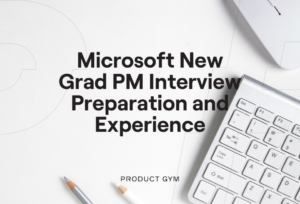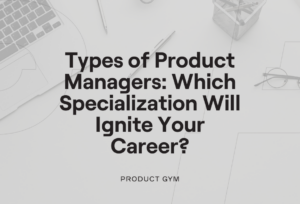We’ve mentored more than a thousand aspiring Product Managers, and if there is one thing we know for sure about the Product Manager interview process: it’s the fact that more than 90% of the candidates fail the product manager case study interview one way or another. Along with the commonly assigned take home assignment and the presentation that follows, this round is notorious for its technical and whiteboarding interview questions.
The vicious case study round of the interview eliminates many aspiring Product Managers who otherwise show great potential. It can cause many candidates to question their product management abilities as a whole. If you have been let down by your case study interview and don’t have the motivation to keep trying, read on! In today’s article, we will show you the four simple steps you need to master the dreaded whiteboarding interview questions in your case study round.
What You Need to Know About Case Study Interviews
Before we dive in, we want to clarify one common misconception about these interviews. Many novice candidates believe that the case study round will always involve a take-home assignment, which would allow them to do extensive research on the question at hand.
While take-home assignments do come up often enough, unfortunately, that’s not always the case. Prepare for your case study interview to involve on-the-go questions. You should also expect to whiteboard and solve problems on the fly during the interview. When that’s the case you’ll have seconds — or minutes if you’re lucky — instead of days to tackle the problem.
When you encounter whiteboarding questions, here are the four steps to follow to keep you on track for a successful interview.
Step 1: Keep Calm and Embrace the Fact that You Know Nothing
You might think that your lack of product management skills caused you to fail your last case study interview, but the reality is that you failed because you panicked! And you panicked because you didn’t have enough information about the case you were tackling.
But guess what, Jon Snow, in real life Product Managers don’t have enough information about the problem they were asked to solve either. They are forced to think and create on their feet and acquire more information to clarify the situation.
If intelligence is readily available to them, why would companies go on crazy hiring sprees to find the best Product Managers to solve their problems? Having seen many candidates interview, we can confirm that many interviewees disqualify themselves in this first step by showing the interviewer that they are not ready to tackle ambiguous real-life issues.
So, by keeping calm and accepting the fact that you have insufficient information about the problem that’s thrown at you, you’ll be a step ahead of your competitors!
What Whiteboarding Interview Questions Can You Expect?
This is also an excellent opportunity to talk a bit more about the questions you should expect during a typical whiteboarding interview session. Many FAANG companies that prefer to ask these kinds of problems during the case study round tend to ask general questions not necessarily related to their business.
For instance, some of the technical case study interview questions Facebook interviewers often ask have nothing to with Facebook’s business:
Facebook Case Study Question Examples
- What would you build if you were the PM of Wikipedia?
- Design a Product the help users find doctors on Facebook
- Should Facebook enter the dating market?
- How would you monetize Facebook Messenger?
Step 2: Try to Understand What the Question Wants You to Achieve
Companies ask whiteboarding interview questions to see if you can create or improve a product that can accomplish a specific goal. When you take on any case study question, rather than focusing on answering the question, you should first take a step back and think about what the question wants you to accomplish with the product.
For most cases, you should be able to divine the purpose of the question from how the interviewer forms it. Our case study instructors have identified four specific purposes:
- Prioritization
- Product Design
- Target Market Identification
- Product Launch
For instance, in the example question above about whether Facebook should enter the dating market or not, you can somehow tell that the question is more about making a decision rather than designing a product.
The interviewer is asking you to evaluate whether the online dating market would be a profitable field for Facebook to enter. With that kind of intuition, you should tell that the interviewer is looking to see how you would prioritize this option:
“What are we prioritizing this against?”
Well, that’s where you get creative (intuitively, of course!) to see what kinds of comparisons you can make. You can talk about the current online dating market or try to crunch some numbers to see how many people of a specific segment would be interested in using your platform to land their next bae.
Noticed the word ‘specific segment’ above? That’s what we’ll tackle next with cracking our case study question.
Determining the purpose behind vague questions and finding the right approach to address them requires a lot of focused practice with real case study questions. If you feel like you need more training, check out the free Product Gym Case Study course to access the instructor-led whiteboarding sessions with real FAANG interview questions.
Step 3: Narrow Down the Question as Much as Possible
You don’t have the time or the resources to consider every possible case for Facebook’s potential as a dating app. You need to narrow down this question as much as possible to come up with some real and data-driven conclusions.
Given that you already have little to no resources available to you, you are expected to make some realistic estimations. Accurate estimations are only possible if you narrow down the question as much as possible.
Let’s assume that you want to focus on the current competitive landscape, and to make things simpler, let’s take a closer look at a single application: Hinge. We will be asking a few fundamental questions to see if Facebook dating survive Hinge’s competition.
Case Study Example Question Breakdown
- Why do people prefer to use Hinge instead of Facebook? Because they want to meet and date new people. Facebook is not designed to help people meet new people (well, most of the cases!), it’s designed to help people keep up with their friendships.
- How does Hinge suggest matches? Can Facebook do the same? Hinge bases its suggestions on the person’s profile, and trains the algorithm as the person likes more profiles. This way, the software has more data to suggest new and more suitable people based on their preferences. Given that Facebook uses its user’s data in multiple ways, it can accomplish the same task. In terms of technical expertise and resources, Facebook is more accomplished in terms of making the best use of data, so chances are Facebook can come up with way more accurate suggestions than Hinge!
- How can Facebook monetize this feature? Given that Hinge’s most basic version is for free and Facebook doesn’t have any features (that we know of!) that actively asks for the user to pay, it might take a considerable effort to make the customer pay for it. Alternative monetizing ways might be through targeted ads, similar to the way the main Facebook interface works.

You need to ask more questions to see if Facebook has what it takes to acquire a segment of the market, but you can see that the thought process is way more specific than the given question.
As you can see, there is a great demand to think this through. and if you believe that this thought process is only one-sided, then you’re wrong! Your whiteboarding should involve as much questioning as possible.
Step 4: Keep the Conversation Alive by Asking These Questions
Communication is an essential part of the case study interview, and you should keep your interviewer informed about every aspect of your thought process.
After you identify the whiteboarding question’s purpose, clearly inform your interviewer what direction you want to take and your reasoning. In the case of our exampe, your answer will determine if Facebook stands a chance of surviving in the online dating market and you will decide based on its compatibility against a competitor, Hinge.
Check your reasoning with your interviewer by asking them if this is something on their mind or if this is something they would consider. In most cases, they would either have an answer key or a direction on their mind and would be able to help you.
Once you agree on the direction you take, ask more specific questions. For instance, you’ll be using Hinge to compare because it contains some key features that Facebook already has. Examples include suggesting people based on profile, a messaging interface, etc.
Don’t ask questions just to ask questions. Try to extract as much information as possible or get a confidence vote from the interviewer that you are on the right track.
Last but not least, make your interviewer’s life easier by suggesting options and giving details while asking questions.
Need More Whiteboarding Interview Advice?
Getting a product manager job has never been tougher and we exactly know how to get you there! If you need more help, schedule a free consultation with us today to find out how we can help you!



